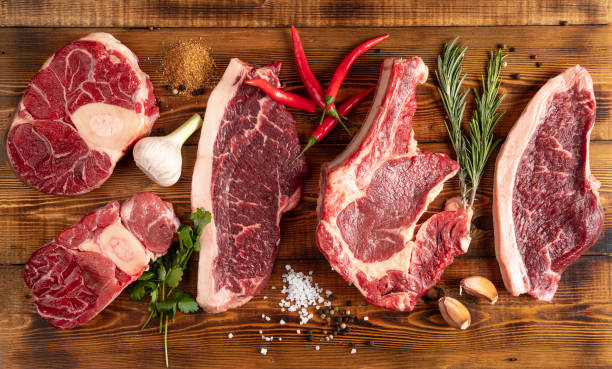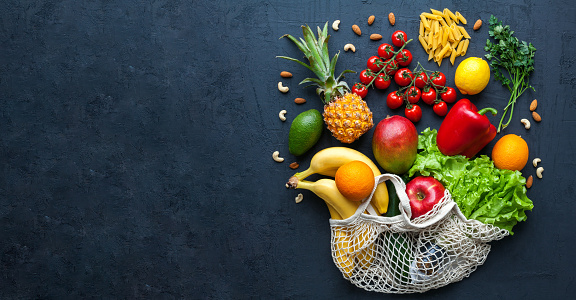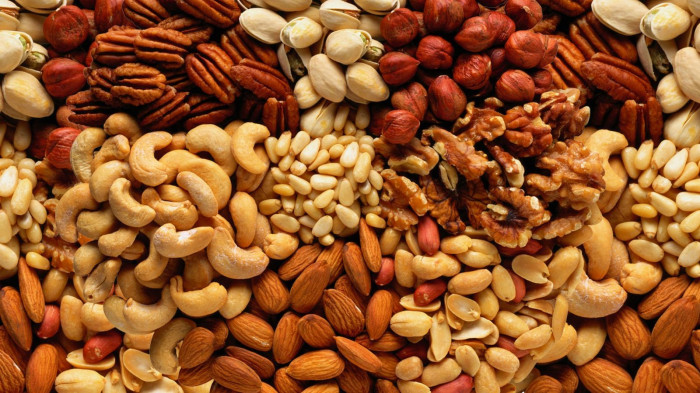Fresh Meat
Fresh meat means meat not subject to any preservation process except chilling, freezing, or fast freezing, including vacuum-packed meat or meat packed in a controlled atmosphere.
Frozen Meat
Frozen meat must usually be thawed before cooking or further processing. Often only partial thawing (known as tempering) is carried out, as tempered meat is firmer than completely thawed meat and can be more easily sliced or flaked. This article covers both the thawing and tempering processes.
Fresh Fruits
India's diverse climate ensures the availability of all varieties of fresh fruits & vegetables. It ranks second in fruits and vegetable production in the world, after China. As per National Horticulture Database (Second Advance Estimates) published by National Horticulture Board, during 2020-21, India produced 102.48 million metric tonnes of fruits and 200.45 million metric tonnes of vegetables. The area under cultivation of fruits stood at 9.6 million hectares while vegetables were cultivated at 10.86 million hectares.
According to FAO (2020), India is the largest producer of ginger and okra among vegetables and ranks second in the production of Potatoes, Onions, Cauliflowers, Brinjal, Cabbages, etc. Amongst fruits, the country ranks first in the production of Bananas (26.29%), Papayas (43.26%), and Mangoes (including mangosteens and guavas) (45.14%).
The vast production base offers India tremendous opportunities for export. During 2021-22, India exported fresh fruits and vegetables worth Rs. 11,412.50 crores/ 1,527.60 USD Millions which comprised fruits worth Rs. 5593 crores/ 750.7 USD Millions and vegetables worth Rs. 5745.54 crores/ 767.01 USD Millions. The processed fruits and vegetables including pulses exported to be Rs. 12,858.66 crores/ USD 1,724.88 million which comprised of processed vegetables including pulses Rs. 8308.04 Crores/ USD 1114.19 million and processed fruits and juices Rs. 4550.62 crores/ USD 610.69 million in 2021-22.
Grapes, Pomegranates, Mangoes, Bananas, and Oranges account for the larger portion of fruits exported from the country while Onions, Mixed Vegetables, Potatoes, Tomatoes, and Green Chilly contribute largely to the vegetable export basket.
Major destinations for the Indian fresh fruits and vegetables are Bangladesh, UAE, Nepal, Netherlands, Malaysia, Sri Lanka, the UK, Oman, and Qatar.
Major destinations for the Indian processed fruits and vegetables are the USA, UAE, China, Netherlands, UK, and Saudi Arabia. Though India's share in the global market is still nearly 1% only, there is increasing acceptance of horticulture produce from the country. This has occurred due to concurrent developments in the areas of state-of-the-art cold chain infrastructure and quality assurance measures. Apart from large investments pumped in by the private sector, the public sector has also taken the initiative with APEDA for setting up several Centers for Perishable Cargoes and integrated post-harvest handling facilities in the country. Capacity-building initiatives at the farmers, processors, and exporters levels have also contributed towards this effort.
Dry Fruits
Dried fruit is fruit that has had almost all of the water content removed through drying methods.
The fruit shrinks during this process, leaving a small, energy-dense dried fruit.
Raisins are the most common type, followed by dates, prunes, figs, and apricots.
Other varieties of dried fruit are also available, sometimes in candied form (sugar coated). These include mangoes, pineapples, cranberries, bananas, and apples.
Dried fruit can be preserved for much longer than fresh fruit and can be a handy snack, particularly on long trips where refrigeration is not available.
Rice
Rice is the seed of the grass species Oryza sativa (Asian rice) or less commonly Oryza glaberrima (African rice). The name wild rice is usually used for species of the genera Zizania and Porteresia, both wild and domesticated, although the term may also be used for primitive or uncultivated varieties of Oryza.
As a cereal grain, domesticated rice is the most widely consumed staple food for over half of the world's human population, especially in Asia and Africa. It is the agricultural commodity with the third-highest worldwide production, after sugarcane and maize. Since sizable portions of sugarcane and maize crops are used for purposes other than human consumption, rice is the most important food crop with regard to human nutrition and caloric intake, providing more than one-fifth of the calories consumed worldwide by humans. There are many varieties of rice and culinary preferences tend to vary regionally.
The traditional method for cultivating rice is flooding the fields while, or after, setting the young seedlings. This simple method requires sound irrigation planning but reduces the growth of less robust weed and pest plants that have no submerged growth state, and deters vermin. While flooding is not mandatory for the cultivation of rice, all other methods of irrigation require higher effort in weed and pest control during growth periods and a different approach for fertilizing the soil.
Rice, a monocot, is normally grown as an annual plant, although in tropical areas it can survive as a perennial and can produce a ratoon crop for up to 30 years. Rice cultivation is well-suited to countries and regions with low labor costs and high rainfall, as it is labor-intensive to cultivate and requires ample water. However, rice can be grown practically anywhere, even on a steep hill or mountain area with the use of water-controlling terrace systems. Although its parent species are native to Asia and certain parts of Africa, centuries of trade and exportation have made it commonplace in many cultures worldwide. Production and consumption of rice is estimated to have been responsible for 4% of global greenhouse gas emissions in 2010.
Spices
A spice is a seed, fruit, root, bark, or other plant substance primarily used for flavoring or coloring food. Spices are distinguished from herbs, which are the leaves, flowers, or stems of plants used for flavoring or as a garnish. Spices are sometimes used in medicine, religious rituals, cosmetics, or perfume production. For example, vanilla is commonly used as an ingredient in fragrance manufacturing.
A spice may be available in several forms: fresh, whole dried, or pre-ground dried. Generally, spices are dried. Spices may be ground into a powder for convenience. A whole dried spice has the longest shelf life, so it can be purchased and stored in larger amounts, making it cheaper on a per-serving basis. A fresh spice, such as ginger, is usually more flavorful than its dried form, but fresh spices are more expensive and have a much shorter shelf life. Some spices are not always available either fresh or whole, for example turmeric, and often must be purchased in ground form. Small seeds, such as fennel and mustard seeds, are often used both whole and in powder form.
Although health benefits are often claimed for spices, there is currently not enough research conducted to prove these benefits.
India contributes to 75% of global spice production. This is reflected culturally through their cuisine; historically, the spice trade developed throughout the Indian subcontinent, as well as in East Asia and the Middle East. Europe's demand for spices was among the economic and cultural factors that encouraged exploration in the early modern period.







